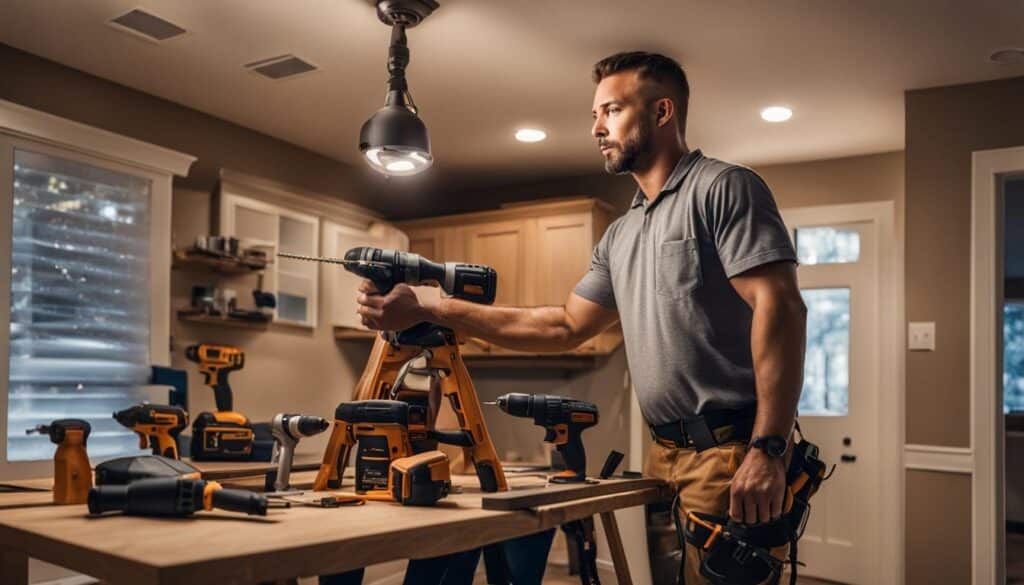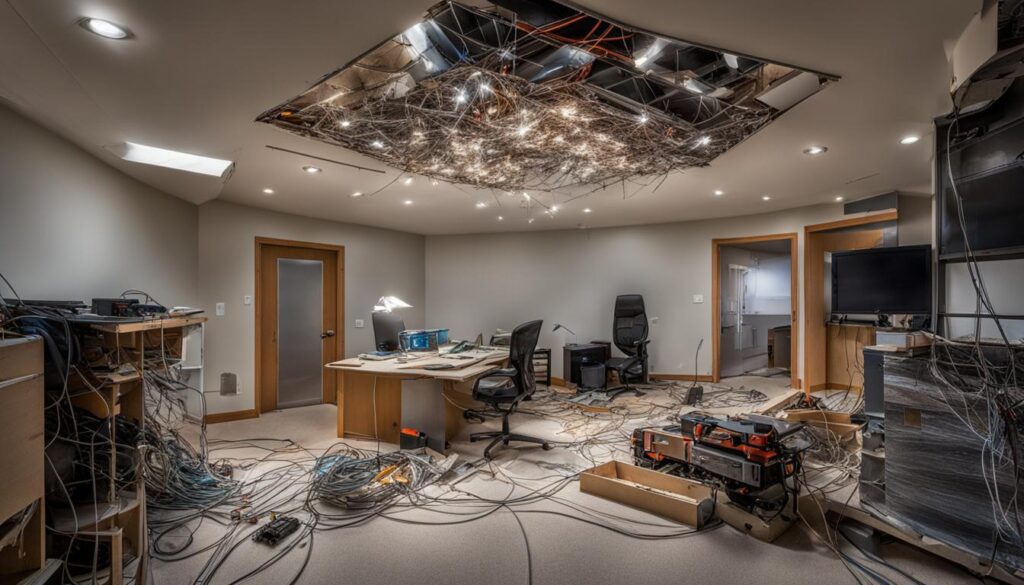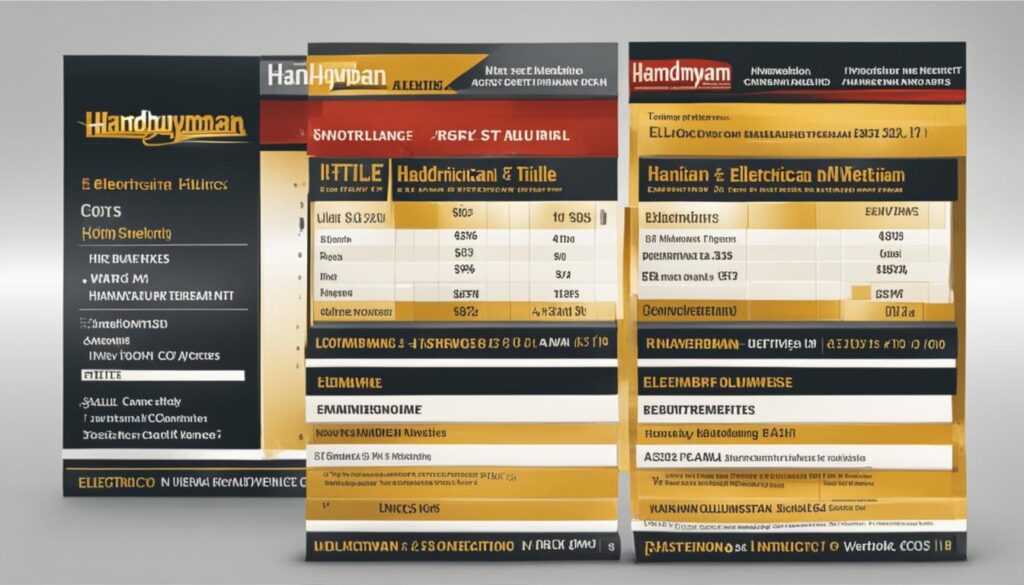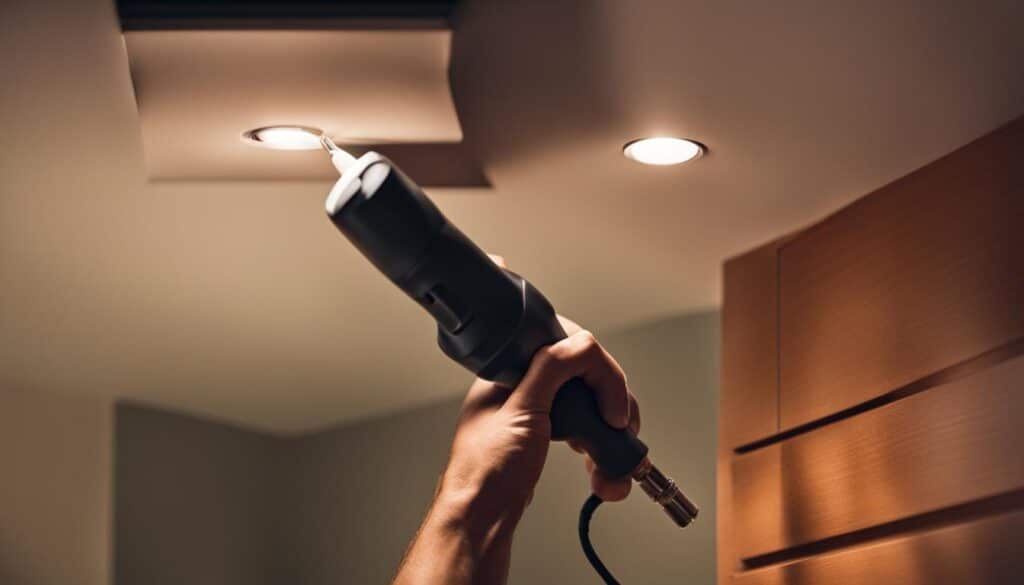When considering upgrading your home’s lighting, many homeowners contemplate whether recessed lighting installation should be a DIY endeavor or if they should hire a handyman for electrical work. The answer largely depends on the handyman’s qualifications, skills, and familiarity with electrical standards. In this article, we examine if a handyman is capable of handling such installations, focusing on important factors like electrical expertise, safety compliance, and aesthetic considerations.
Key Takeaways
- Electrical expertise is crucial for safe and compliant recessed lighting installation.
- Not all handymen are qualified to install recessed lighting; always verify their skills.
- Handyman services may be more affordable than hiring a licensed electrician.
- DIY installation can be an option but requires a solid understanding of electrical systems and local codes.
- Recessed lighting enhances a room’s aesthetic and requires precision in placement and design.
Demystifying Recessed Lighting Installation
Recessed lighting, also known as can lighting, has become a popular choice for homeowners seeking to create a refined atmosphere and enhance room aesthetics. However, the process of how to install recessed lighting is not without its complexities. It involves integrating the lighting into the home’s electrical system safely, accurately installing fixtures into the ceiling, and determining the ideal arrangement for even light distribution. These steps underscore the necessity of an informed approach, whether executed by a tenured handyman or a skilled homeowner.
Understanding the different components involved in recessed lighting installation is crucial to ensure a successful outcome. Some essential aspects of the process include:
- Assessing the home’s electrical wiring and planning the installation accordingly.
- Selecting suitable recessed light fixtures and associated accessories, such as housing, trim, and bulbs.
- Ensuring compliance with local electrical wiring and safety codes.
- Measuring and marking the ceiling to designate the placement of fixtures.
- Cutting holes in the ceiling for the recessed light housings.
- Installing and securing the housings, wiring them to the existing electrical system.
- Adding the trim and light bulbs, and testing the functionality of the lighting.
Whether you opt for handyman services or attempt to install the lighting yourself, it is essential to familiarize yourself with these aspects of the installation process. Moreover, certain considerations must be made before beginning the project:
- Ensure that your home’s electrical system is capable of supporting the additional lighting.
- Choose the appropriate type and number of recessed light fixtures based on room size and intended purpose.
- Acquire any required permits for electrical work, if necessary.
- Be prepared to make adjustments, such as relocating wires, pipes, or HVAC ducts, to accommodate the desired lighting layout.
Recessed lighting installation can be a considerable undertaking, requiring a diligent and informed approach. While some homeowners may feel confident in their abilities to carry out the installation themselves, many may find that seeking the help of a skilled handyman or electrician is the safest and most efficient choice. Whichever path you choose, understanding the complexities of the process and adhering to electrical wiring and safety codes will ensure a polished, professional result that enhances your home’s aesthetic appeal.
The Essential Skills a Handyman Must Have for Recessed Lighting
For homeowners contemplating whether a handyman is apt in installing recessed lighting, they must consider the fundamental skills required to execute such a project successfully. A proficient handyman needs at least three essential competencies: an understanding of electrical basics, precision in cutting and fixture installation, and a strong eye for design and aesthetics. In this section, we explore in detail what expertise a handyman must have in these areas to ensure a seamless recessed lighting installation.

Electrical Knowledge Basics
A competent grasp of electrical systems is the foundation for any successful recessed lighting installation. Such knowledge helps ensure that the installation process is conducted safely and complies with electrical codes. A handyman must be capable of understanding wiring, circuits, grounding, and electrical code requirements—all crucial to prevent potential hazards.
Precision in Cutting and Fixture Installation
The process of recessed lighting installation demands exactitude in cutting ceiling holes and securing fixtures. This necessitates the handyman’s precision and capability to work with a variety of materials to achieve a finished look. Proficiency with tools such as hole saws and measuring devices is crucial for accurate hole placement and fixture mounting. Greater precision in these aspects results in an aesthetically pleasing outcome with minimal room for error.
Design and Aesthetic Consideration
Strategic placement of recessed lights plays a pivotal role in achieving the desired visual appeal and lighting balance. A handyman with a discerning eye for design is better equipped to guide fixture spacing and positioning, ensuring that the installation complements the surrounding space. Factors to consider include room size, ceiling height, and existing layout, all of which can contribute to creating a balanced and harmonious lighting arrangement. Ultimately, this artistic input distinguishes a satisfactory installation from one that truly elevates the room’s aesthetics.
DIY vs. Professional Installation: What to Consider
When contemplating DIY recessed lighting installation versus professional installation, homeowners must weigh the allure of personal endeavor against the promise of professional quality. Considerations include the depth of electrical acumen required, the intricacies of working within safety standards, and the reliability that comes with expertise, all of which shape the ultimate decision to entrust a handyman, take on the challenge oneself, or engage a licensed electrician.
To facilitate your decision-making process, we’ve compiled a list of key factors to consider when deciding between a DIY approach, hiring a handyman for recessed lighting, or electrician vs handyman for recessed lighting:
- Electrical expertise: Installing recessed lighting requires a solid understanding of electrical systems, wiring, and safety procedures. While a DIY approach may seem enticing, it could be risky without the proper know-how.
- Safety standards: Strict building codes and safety standards must be followed during the installation process to prevent potential hazards. Professionals are better equipped to ensure compliance and minimize risk.
- Quality and reliability: Entrusting the task to a professional can guarantee a higher level of craftsmanship and dependability, as they have the experience necessary to efficiently install recessed lighting.
Remember: The success and safety of your recessed lighting installation rests in the hands of the individual tasked with the job, be it yourself, a handyman, or an electrician. Weigh your options carefully to make an informed decision.
For a better understanding of the implications of your choice, compare the options using the table below:
| DIY Installation | Handyman | Electrician | |
|---|---|---|---|
| Cost | Low | Medium | High |
| Expertise | Varies | General | Specialized |
| Quality | Depends on skill level | Good | Excellent |
| Safety and Compliance | Uncertain | Probable | High |
| Time and Convenience | Flexible | Faster than DIY | Optimal, but subject to schedule |
Consider the factors outlined above as a guide to inform your decision on whether to embark on a DIY installation, hire a trusted handyman, or enlist a licensed electrician. Ultimately, the choice will depend on your personal preferences, budget, and level of confidence in your own abilities or the capabilities of your chosen professional.
Understanding the Complexity of Recessed Lighting Projects
Recessed lighting projects are a sophisticated blend of design aesthetics and intricate electrical work. In order to guarantee a successful, safe, and visually appealing installation, understanding the technical aspects of the process is crucial. Two core components to consider for this type of project are electrical wiring and safety codes as well as fixture types and ceiling compatibility.
Electrical Wiring and Safety Codes
Meticulous attention to detail is crucial when dealing with electrical wiring and safety codes. Complying with local safety standards will ensure a robust installation and prevent potential hazards. Proper connections and grounding are essential to avert electrical mishaps. Additionally, staying abreast of evolving local and state regulations is paramount to guarantee ongoing compliance with building codes.
Installation protocols demand a stringent adherence to safety practices, with proper connections and grounding vital to avert electrical mishaps, and a nuanced knowledge of local codes to guarantee compliance.
Fixture Types and Ceiling Compatibility
Various fixtures present unique installation dynamics, making proper assessment of compatibility against ceiling types crucial. This critical step helps prevent overheating and fortifies fire safety in insulated environments. A thorough understanding of fixture types and their corresponding ceiling compatibility is essential in delivering a high-quality and secure installation.

Recessed lighting projects pose distinct challenges with regard to both electrical and design aspects. Therefore, staying informed about the latest safety practices, industry standards, and fixture innovations can help secure a successful outcome. Moreover, it is essential to consult with professionals in the field for guidance, as they can provide valuable insight and expertise.
- Stay informed of local and state building codes pertaining to electrical systems.
- Understand the unique installation dynamics of various fixtures and ensure compatibility with ceiling types.
- Consult with professionals for guidance on best practices and industry standards.
In conclusion, an appreciation for the complexity of recessed lighting projects is crucial in achieving a successful installation. By remaining knowledgeable about electrical wiring, safety codes, fixture types, and ceiling compatibility, a smooth and satisfactory outcome can be realized.
The Role of a Handyman in Electrical Work
Handyman services are often sought for projects related to electrical systems, including the installation of recessed lighting. The role of a handyman in this capacity relies on their familiarity with basic electrical concepts and the ability to execute the task with precision, keeping safety and design preferences at the forefront.
When deciding if a handyman can install recessed lighting, it is essential to consider their range of expertise in navigating the intricacies of electrical systems. Some key aspects a handyman must be knowledgeable about include:
- Electrical wiring and circuitry
- Grounding and safety practices
- Local and regional electrical codes
A handyman’s proficiency in these areas is crucial for ensuring the overall success and safety of the installation. Furthermore, a deep understanding of how to install recessed lighting entails that they have the necessary skillset to make educated decisions regarding design elements, such as the placement of fixtures and the selection of appropriate lighting sources.
Another integral part of a handyman’s role in electrical work is the commitment to maintaining safety standards throughout the process. This includes adhering to established electrical codes, taking precautionary measures while handling live wires, and using proper tools and equipment.
“A handyman’s foremost responsibility is to provide reliable and safe services – and this extends to their work in electrical systems like recessed lighting installations.”
In the realm of design, a handyman contributes to the coherent execution of recessed lighting by employing aesthetic consideration in the placement and arrangement of fixtures. This is important for achieving an even light distribution and an overall seamless integration and lighting experience within the space.
In conclusion, the role of a handyman in electrical work is multifaceted and hinges upon their ability to navigate the complexities of electrical systems while maintaining an unwavering commitment to safety and design coherence. Their proficiency in these areas determines their capability to install recessed lighting and ultimately, the success of your home improvement project.
Cost Comparison: Handyman vs. Electrician for Recessed Lighting
When planning for the installation of recessed lighting, one crucial aspect to consider is the cost. Homeowners often face the dilemma of which professional to hire – a handyman or a licensed electrician. The costs involved in installing recessed lighting can differ significantly based on the project’s complexity and scale, as well as the specific expertise required for the job. In this section, we will compare the costs associated with hiring a handyman and an electrician for recessed lighting installation.

Keep in mind that the costs presented here are general averages and can vary based on location, project requirements, and labor rates in your area.
| Professional | Average Cost per Fixture | Additional Fees |
|---|---|---|
| Handyman | $50 – $100 | Consultation fee (if applicable) |
| Electrician | $100 – $200 | Inspection or permit fees, in-depth electrical work |
A handyman typically charges less than an electrician for installing recessed lighting. However, electricians possess a higher level of expertise in electrical services, which may be necessary, depending on the complexity of your project. Moreover, hiring a licensed electrician can ensure compliance with local electrical codes and offer greater assurance of safety.
Keep these cost comparisons in mind as you decide on the best professional for your recessed lighting installation. Ultimately, the choice between a handyman and an electrician should prioritize safety, compliance, and the desired quality of work.
Handyman Services and Code Compliance for Lighting Installation
Installing recessed lighting is a task that demands attention to detail, as well as adherence to local and state building codes. Hiring a handyman for recessed lighting is a viable option, provided they possess the required knowledge of code compliance. This section explores the importance of meeting code requirements and the benefits of hiring licensed professionals to ensure a safe and successful installation.
When a Handyman Meets the Code Requirements
A handyman who possesses extensive knowledge of local and state building codes can ensure that the recessed lighting installation proceeds smoothly and in compliance with all regulations. This includes abiding by safety standards, grounding, and proper wiring, thereby reducing the risk of hazards and complications.
“By hiring a handyman who meets the code requirements, homeowners can feel confident in the functionality and legality of their recessed lighting installation.”
It’s crucial for handyman services to be code-compliant, as non-compliance can lead to fines, voided warranties, and even the requirement to remove the installed lighting system. Therefore, it is highly recommended to entrust installation projects to professionals who are experienced in navigating regional electrical standards.
The Importance of Hiring Licensed Professionals for Compliance
The gravity of compliance with safety and building regulations underscores the necessity of engaging licensed professionals who are adept in navigating regional electrical standards to safeguard both the dwellers and infrastructure. Licensed professionals, whether handymen or electricians, possess the skills and certifications necessary to ensure a recessed lighting installation adheres to relevant building codes.
Some advantages of hiring licensed professionals for code compliance include:
- Peace of mind knowing the installation is safe and compliant
- Reduced risk of voided warranties or insurance issues
- High-quality workmanship, ensuring a polished and professional finish
In conclusion, hiring a handyman who is knowledgeable about code compliance is essential to ensure a successful, safe, and legal recessed lighting installation. Entrusting the job to licensed professionals guarantees the adherence to local and state building codes, safeguarding both the home and its occupants from potential hazards.
Recessed Lighting Tips and Tricks from the Pros
Recessed lighting installations offer an attractive solution for modern spaces, adding an ambience of sophistication and style. Drawing on the expertise of professional lighting services, we have compiled a selection of tips and tricks to optimize your recessed lighting endeavors.

Implementing these insights will not only enhance the visual appeal of your space but also ensure the longevity and efficiency of your lighting system.
- Plan your layout carefully: Before drilling any holes in your ceiling, take the time to design a well-thought-out lighting plan that considers the architectural elements, furniture placement, and desired focal points within the space. In doing so, you ensure a harmonious blend of function and form.
- Space your recessed lights evenly: To avoid uneven or harsh lighting effects, space your recessed lights approximately 2 feet away from the wall and from one other. Account for any beams or structural elements that may obstruct installation.
- Layer your lighting: Create a multi-dimensional lighting scheme by combining several layers of light, such as accent lighting, task lighting, and ambient light. This approach will yield a dynamic and well-balanced lighting atmosphere.
- Choose the appropriate trim and housing: Consider the specific needs of the space when selecting your trim and housing materials. For example, moisture-resistant housings are essential for lighting installations in kitchens and bathrooms.
- Consider energy-efficient options: LED lights, for instance, not only have a longer lifespan but also consume less energy than traditional incandescent bulbs, making them an environmentally friendly and cost-effective choice.
“A well-designed lighting scheme can transform the aesthetic and ambiance of a space, elevating it from ordinary to extraordinary.”
Moreover, engaging professional lighting services for your recessed lighting installation ensures that your project is executed to the highest standard of workmanship, safety, and design coherence.
| Tip | Description | Benefit |
|---|---|---|
| Layered Lighting | Combine accent, task, and ambient lighting | Dynamic, well-balanced lighting atmosphere |
| Energy-Efficient Options | Utilize LED bulbs and other eco-friendly choices | Lower energy bills, longer-lasting bulbs, and environmental sustainability |
| Appropriate Trim and Housing | Select materials based on specific room requirements | Optimal performance, durability, and aesthetics |
| Even Spacing | Maintain consistent distances between lights | Uniform illumination, reduced shadows and glare |
| Professional Assistance | Seek guidance from professional lighting services | Expert workmanship, safety assurance, and design coherence |
In conclusion, addressing these recessed lighting tips and tricks can significantly enhance the beauty and efficacy of your installation. An investment in professional lighting services can further ensure the durability, safety, and design finesse of your project, culminating in spaces that are both visually stunning and functionally adept.
Conclusion
Recessed lighting installation is a multifaceted undertaking, delicately balancing the demand for electrical proficiency against design finesse. When it comes to deciding who should install your recessed lighting, it is essential to factor in the intricacies of the project, your budget, and the importance of safety requirements.
Handyman services can prove to be a viable option for those seeking skilled professionals in both electrical and aesthetic aspects. However, understanding the extent of their knowledge and how it compares to licensed electricians is crucial in determining the best course of action for your specific situation.
In conclusion, the choice between a handyman or an electrician for your recessed lighting installation should be an informed decision, rooted in project complexity, safety imperatives, and the pursuit of an elevated aesthetic. By considering these factors, you can confidently embark on transforming your living space with professionally installed recessed lighting.
FAQ
Can a handyman install recessed lighting?
A handyman can install recessed lighting if they are proficient in electrical work, have a solid understanding of local codes and regulations, and are skilled in cutting and securing fixtures. The decision to hire a handyman, an electrician, or attempt a DIY installation depends on the complexity of the project and the desired results.
What skills should a handyman have for installing recessed lighting?
A handyman should possess basic electrical knowledge, precision in cutting and fixture installation, and an eye for design and aesthetics when installing recessed lighting. It is also important for them to have a clear understanding of local safety codes and regulations for electrical work.
What should I consider when deciding between DIY or professional installation of recessed lighting?
When deciding between a DIY or professional installation of recessed lighting, consider the depth of electrical knowledge required, the complexity of the project, adherence to safety standards, the ideal placement of fixtures for desired lighting balance, and the overall reliability that comes with professional expertise. Weigh these factors against your own skills, time, and budget to decide the best course of action.
How do the costs of hiring a handyman and an electrician for recessed lighting installation compare?
The costs of installing recessed lighting may vary based on the scope, scale, and intricacy of the project. While handymen typically charge a lower hourly rate than electricians, more complex installations may require the specialized expertise of an electrician, which could influence the overall project cost. Weigh the specific demands of your project and budget when deciding between a handyman and an electrician.
Are there any tips and tricks for recessed lighting installation?
Recessed lighting tips and tricks include strategic placement of fixtures for balanced light distribution, installing dimmer switches for customizable illumination, choosing the right size of recessed lights for your room, and ensuring compatibility with various ceiling types to prevent overheating and ensure fire safety.
How important is code compliance in recessed lighting installation?
Code compliance is crucial in recessed lighting installation to ensure adherence to safety standards and building regulations. This is particularly important if selling or insuring your property. It is important to hire licensed professionals who are knowledgeable about local electrical standards and can ensure a safe and compliant installation.

